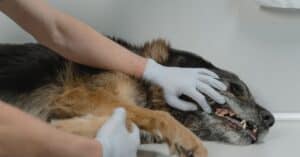A very healthy breed, Cocker Spaniels have been quite the talk of the town. With their amazing small-medium bodies and a majestic fluffy stature, they are the perfect companions for both active bachelors as well as families with small children and other pets. However, given certain factors, this beautiful breed could be prone to certain health anomalies.
Hip Dysplasia, Atopy, PRA, eye, ear, and skin problems constitute the most frequently reported medical conditions, with some also suffering from more severe conditions.
So, today in this blog we will be covering the many health issues in Cocker Spaniels and what needs to be done in these cases.
Table of Contents
What are the factors that contribute to Health Issues in Cocker Spaniels?
Depending upon their breeding, parents’ genes and medical history, the health quality of a Cocker Spaniel pup can vary differently. The same also goes for their living conditions, feeding regimen, and exercising level. As they are known to be quite lively and high energy woofers, a regularity must be maintained in their grooming, feeding and exercising schedule for the very best results. Otherwise, their bodies start gaining too many fat layers which is never good.
Moreover, it is also essential to remember that a poorly exercised puppy is also prone to being destructive towards its surroundings, no matter if it’s a toy, expensive furniture or even other things. And so if you don’t want to watch your home get into a messy disaster every time you walk out of the house, you will need to stake up your efforts.
What are the most common Cocker Spaniel Health Issues?
A purebred Cocker Spaniel can be susceptible to:
Eye Problems
- Keratoconjunctivitis Sicca (KCS or Dry Eye)
Also known as Dry Eye, a pooch suffering from this typical condition is unable to produce enough moisture in their eyes due to a damaged tear gland. As a result, the eye sockets seem extremely dry and could get easily infected. Such Spaniels often have a gloomy, soul-less expression, which is unfortunately a life-long health condition.
There is no treatment for KCS and suffering canines will require life-long commitment and proper care to prevent further worsening.
- Glaucoma
One of the most painful conditions for a Cocker Spaniel, Glaucoma occurs when there is an increased pressure on their eye. It can happen in one or both of their eyes and is known to be very excruciating. The condition progresses rapidly and is frequently followed by redness of the eyes, excessive squinting, cloudy vision, watery eyes, etc.
Given its severity, leaving it unattended can also lead to blindness and hence should be catered to promptly. Glaucoma can be both hereditary or may also result due to physical trauma, so spaniel parents need to be very alert.
Heart Problems
Although very rare, heart problems are also frequent in pooches with questionable progeny. For instance, if a purebred Cocker Spaniel is bred with a mutt that doesn’t have proper health standards, the resulting pups will be automatically inclined to having weak hearts.
Thus, if your pup shows unexplained weakness or is severely lethargic almost all the time, it may mean that they are having a weak heart, rather than being utterly lazy. Similarly, some other telltale signs to look out for include labored breathing, excessive cough, and even fainting or collapsing phases.
In extreme cases, the pooch may also have nasty seizures that could easily lead to even more grave consequences and hence needs to be treated by a vet right away.
Dental Problems
Generally dogs teeth stay clean with the smallest of efforts, including regular or weekly brushing. But given their parents’ progeny, some pups might be more inclined to dental issues than the rest.
Cavities occur as a natural biological process and hence when left untreated for long can lead to many dental hygiene issues. This sticky layer keeps on building, which finally builds up to tartar formation and to more serious consequences, like gingivitis, gum infections, etc.
Moreover, the dirtier the mouth is, the greater the risk of these microbes slipping deeper down into their bodies. In the end, the pooch might have a bad digestive system, and even suffer from kidney and liver problems.
Bone and Joint Problems
Hip Dysplasia
A severely painful medical condition, this is where the hip bone doesn’t fit properly into the socket, causing a tremendous amount of pain when trying to move. This is mostly inherited, but can also be caused due to an extreme physical trauma to the place.
The constant friction between the bones results in swelling, and even arthritis-related conditions that need to be handled by a professional caretaker only. Although there is no sure-cut solution to such a medical issue, medications and physiotherapy can help reduce a lot of pain for the innocent animal.
Patellar Luxation
With both faulty genetics and obesity as the main leading factors, patellar luxation is when the kneecaps move out of the place, leaving the woofer’s legs greatly unstabilized and in need of professional care. This condition is known to aggravate more with age, even though small puppies may suffer from the same in case of the first cause.
Patellar luxation is untreatable, but can be deduced with proper weight management and early diagnosis.
Intervertebral Disc Disease (IVDD)
As we discussed in our last blog, IVDD is another one of the excruciatingly painful diseases where the cushioning disc between vertebrae slips out. This in turn leads to the repeated grinding of the major bones, which although may not be detectable in the early phases can worsen with age, unchecked weight gain, or through a physical trauma.
Thus, if you are worried that your pup might be having any of the problems, consulting with the vet is the first and foremost thing to do. You never know when your pup might completely stop moving, and trust us this is not a sight that any pet parent should ever witness.
Skin and Ear problems
Malassezia Dermatitis
A typical skin condition, it is caused by a yeast that even though is normally present in almost all canines, can do severe damage if they grow rapidly. In case of uncontrolled breeding, they could go into the canine’s ears, causing them itchiness, swelling, hair loss, stinky smell, and even a waxy discharge that looks like pus.
Thus, if lately, you have been finding your beloved fur baby to be smelling more than usual, give them a good sniff and have them checked out by their doctor.
Seborrhoea
Seborrhoea can happen in two forms. One includes dry, flaky skin which is usually covered with painful lesions or the pup’s skin might get abnormally oily or greasy to touch. Like the previous one, it can also result due to microbe infestation but in some cases, it can easily transfer from the parents to the litter.
The only solution here is to consult with a vet, run necessary tests, and apply prescribed lotions or oral medications for a really long time.
Otitis
Otitis is when yeast starts growing in the deeper parts of the ear canal, leading to ear infections. These situations can worsen at an alarming rate leading to pus formation, excessive head shaking, ear scratching, and even a yellowish green pus oozing out of the ears.
To prevent such conditions from further worsening, you will need to take them to a professional vet as soon as possible. There they will be given appropriate treatment based on the severity and cause of the health issue.
Finally, thyroid problems and obesity can also be calculated as some other commonly faced health conditions in Cocker Spaniels. However, fortunately, they aren’t as frequently reported as the above ones.
Do subscribe us to our mailing list and stay on top of our regular blogs on ‘Everything Doggo’.
If you are a dog lover then, Subscribe to our weekly newsletters. No Spams!









